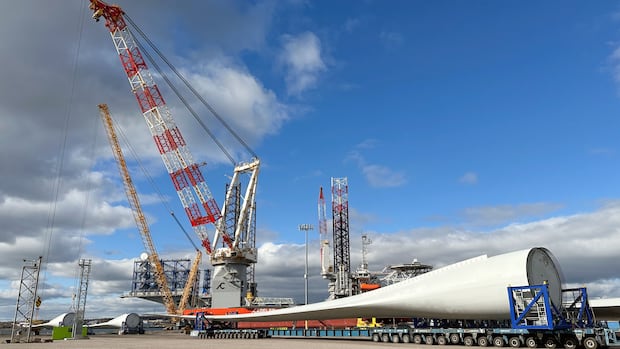Nova ScotiaA Net Zero Atlantic report examined 10 ports and companies on the East Coast and found Atlantic Canada Bulk Terminal in Sydney harbour was at or near the top for readiness and investment required.Atlantic Canada Bulk Terminal identified as a leading contender for East Coast offshore wind portTom Ayers · CBC News · Posted: Nov 05, 2025 12:08 PM EST | Last Updated: 2 hours agoListen to this articleEstimated 5 minutesAtlantic Canada Bulk Terminal in Sydney, N.S., where offshore wind turbine blades were being loaded onto a ship bound for the U.S. on Monday, has been identified as a leading port operation in the bid to bring the industry to Canada. (Tom Ayers/CBC)A potential offshore wind contractor based in Sydney, N.S., says government subsidies may be needed to get the new renewable energy industry off the ground, but it doesn’t need any financial help for its operation.A report this summer by Net Zero Atlantic examined 10 ports and companies on the East Coast and found Atlantic Canada Bulk Terminal in Sydney harbour was at or near the top for readiness and investment required, if offshore wind leases are approved in Canadian waters.The report said hundreds of millions of dollars would be needed to get port operations ready and called for more study on the possible need for financial support.Atlantic Canada Bulk Terminal vice-president Richard Morykot said governments should be investing in public infrastructure, not private companies.”I think we should be careful not to just ask for government money when it may not be needed,” he said. “In terms of government subsidies, I think the government should be looking at the grid and spending their focus and their money on upgrading the grid, because if we don’t have an upgraded grid, we won’t have an offshore wind industry.”At a recent conference, a German expert suggested the offshore wind energy industry takes years to develop and requires large government subsidies to be viable.Vice-president Richard Morykot says Atlantic Canada Bulk Terminal has already invested tens of millions of dollars and is ready to spend more. (Tom Ayers/CBC)Morykot, who attended the conference and heard the speaker’s presentation, said government money would be needed to build and operate offshore wind farms, but not for the contractors who do the work manufacturing and installing the turbines.”There’s billions and billions of dollars required for offshore wind and right now the costs, it’s not competitive with other forms of energy,” he said.”I think he was speaking more to the whole project, the billion-dollar projects, versus ports specifically.”Morykot said the privately owned Atlantic Canada Bulk Terminal has already invested tens of millions of dollars and has been marshalling parts for the U.S. offshore wind industry and is ready to spend more to get ready for the expected boom in Canada.The Net Zero Atlantic study, released in August by a non-profit group of renewable energy experts, suggested the terminal would need to invest $135 million just to get to the first stage of readiness.Read the full reportThat would allow the company to not just store and transfer parts for fixed-bottom wind turbines, but also do some pre-assembly work and start staging the more complex floating turbines.It also said the company would have to spend $230 million to become a full-service port, providing integrated staging and assembly of all kinds of wind turbines, manufacturing some of the parts and testing turbine engines.Morykot said those numbers are already out of date, because the company is continually investing profits into its operation.”We’ve already done some upgrades,” he said.”So to get into the $135 million, that number seems a little bit high from our direct experience, from what we’re doing now. We peg the cost to get into the business at about $50 million to $150 million, versus $135 [million] to $230 [million].”Offshore wind installation ship Wind Pace uses its own and shore-based cranes to load turbine blades at Atlantic Canada Bulk Terminal in Sydney, N.S., on Monday. (Tom Ayers/CBC)The report put the Sydney port operation about even with the port of Argentia, N.L, which is also marshalling parts for U.S. wind farms.It said two ports in New Brunswick could handle the first stage of offshore wind business only, with investment of up to $250 million.The report said the same about Port Hawkesbury, N.S., and Port aux Basques, N.L.The port in Sheet Harbour, N.S., is also doing some marshalling and was identified as being a possible location for a full-service operation, but the report also said that would require nearly $500 million.A study says the proposed Melford Terminal greenfield site in the Strait of Canso would need more than $440 million to become a full-fledged offshore wind site. (Erin Pottie/CBC)The proposed Melford Terminal greenfield site in the Strait of Canso would need more than $440 million to become a full-fledged offshore wind site, while the Novaporte greenfield site, across Sydney harbour from the Atlantic Canada Bulk Terminal, was listed as the second-most expensive operation, needing more than $650 million in investment.The port of Mortier Bay, N.L., was the most expensive and needed the most time to get ready with an estimated cost of nearly $965 million.Port of Sydney Development Corporation CEO Lorna Campbell said Atlantic Canada Bulk Terminal’s entry into offshore wind marshalling has already generated revenue for the port and would likely create huge spinoffs in manufacturing and support services if the industry gets going in Canada.She said an offshore wind vessel associated with the terminal paid to dock at the port’s second pier for several months this past winter, demonstrating what could be a bright future.Lorna Campbell, CEO of the Port of Sydney Development Corporation, says offshore wind has already brought benefits to the port and will help the mainly cruise ship-focused operation diversify its revenues. (Tom Ayers/CBC)”There’s economic benefits to that and that’s just the tip of the iceberg,” she said.About 70 per cent of the port’s business is hosting cruise ships, which Campbell said points to the need to diversify in case of another downturn such as the one during the COVID-19 pandemic.She said with increasingly larger ships now visiting Sydney, the port has identified the need to offer a tugboat service and fuelling and shore power to support the vessels.MORE TOP STORIESABOUT THE AUTHORTom Ayers has been a reporter and editor for 39 years. He has spent the last 21 covering Cape Breton and Nova Scotia stories. You can reach him at tom.ayers@cbc.ca.
Cape Breton company says offshore wind contractors don’t need government subsidies











